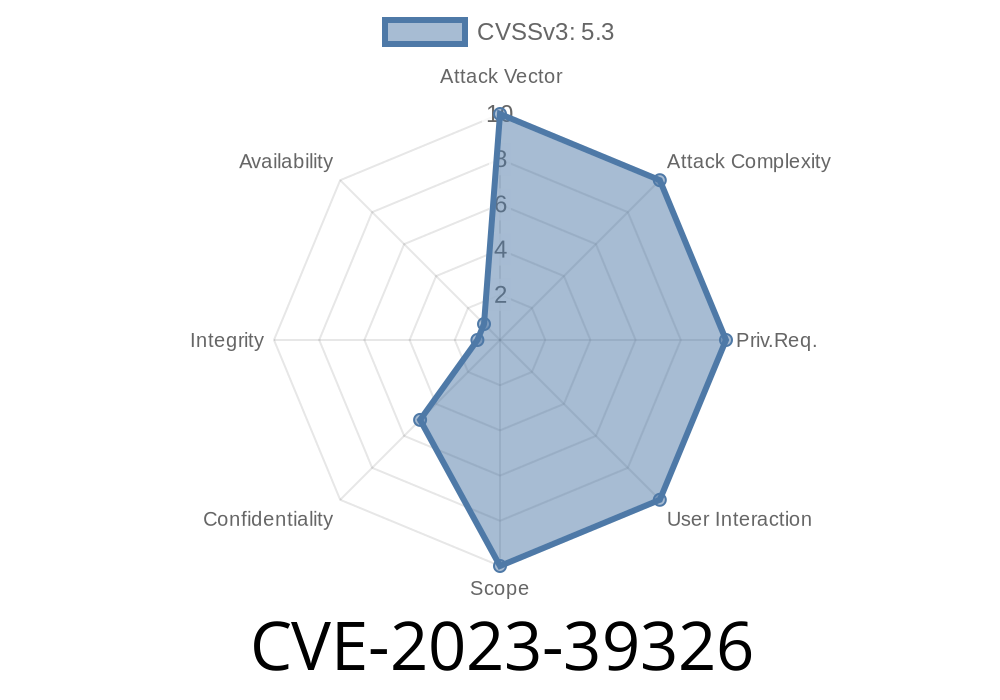As the digital landscape evolves, new security vulnerabilities continue emerging. Today, we will discuss a critical vulnerability - CVE-2023-39326 - which affects HTTP communication and can be exploited by malicious HTTP senders. In particular, they can manipulate the chunk extensions feature to enable remote attackers to read a significantly larger amount of data than intended. Below, we will delve into the details of this vulnerability, including its underground mechanisms, the affected components, and recommended safeguard measures.
Understanding CVE-2023-39326
At its core, CVE-2023-39326 is a vulnerability found in the HTTP communication protocol, mainly targeting servers using the chunked encoding method. In essence, a malicious HTTP sender can exploit this vulnerability through chunk extensions, forcing a receiver to read more bytes from a network than those included in the actual body of a request or response. This allows the sender to manipulate the data transmission process and potentially cause a server with a handler that fails to read the entire body of a request to automatically read large amounts of data—up to approximately 1 GiB.
The underlying mechanism: Chunk extensions
HTTP chunk extensions are a seldom used feature in the HTTP communication protocol which allows the sender to add supplementary metadata in the chunked encoding method while sending a request or response body. Despite being seldom used, the feature's inherent nature can be exploited by malicious senders, chunking (breaking down) data into segments with added metadata.
The net/http chunked encoding reader in most languages (e.g., Go, Python, Node.JS) is designed to nullify such metadata and only process the actual data. However, when an attacker sends data with chunk extensions containing substantial metadata, the reader discards this metadata, causing an increase in the ratio of actual body content to encoded bytes.
Exploiting the vulnerability
To exploit this vulnerability, an attacker can send data with maliciously constructed chunk extensions that create an imbalance between the actual body content and the encoded bytes. By maximally leveraging these chunk extensions, an attacker creates a scenario in which the chunk reader generates an error due to the disproportion between real body content and encoded bytes.
Since the chunked encoding reader discards the metadata, a sender could exploit this vulnerability by inserting a large metadata segment with each byte transferred. The chunk reader now produces an error if the ratio of real body content to encoded bytes is too small.
Mitigating the risk
This vulnerability can be mitigated by updating and patching relevant components and by implementing stringent server-side validation and checks. Developers need to remain cautious when working with HTTP and ensure that their applications are adequately protected against threats, such as the one posed by CVE-2023-39326.
In response to this specific vulnerability, developers should implement a chunk reader with an error-checking mechanism that accounts for and validates the ratio of actual body content to encoded bytes. By doing so, they can create an early warning system that prevents any potentially malicious exploitation of the chunked encoding process.
Conclusion
CVE-2023-39326 highlights a critical vulnerability found within the HTTP chunked encoding mechanism, which leaves unpatched or unprotected systems open to exploitation by malicious senders. Therefore, it is essential for developers and administrators to remain vigilant in the face of such threats and ensure the application of updates, patches, and best practices to maintain the integrity and security of their systems.
Refer to the original sources below for more detailed information and recommendations on dealing with this vulnerability:
1. Official CVE Details
2. HTTP Chunk Extensions
3. Net/HTTP Package in GO
Timeline
Published on: 12/06/2023 17:15:07 UTC
Last modified on: 01/20/2024 04:15:07 UTC
